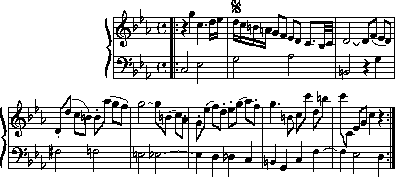Solution to Canon 2. a 2 Violini in unisono

Solution:
[This and the remaining “solution” sections are not in dialogue form, but
are directed to the reader.]
How
many voices are there?
Clefs:
There
is a G-clef in the upper section with a counterpoint voice, and an F-clef in
the lower section with the Royal theme. This, in itself, indicates that there
are at least two voices.
Look
at the title:
The
“a 2” in the title indicates that there are two voices in canon with each
other. “Unisono” indicates that the two voices are identical – in
unison. Since those two voices have to be identical, and played as a canon
with each other, this means that there has to be an additional voice, because
the upper and lower voices that are written out are different. Where could the
other voice be?
Is
there %
?
The
%
above measure 2, in the upper voice, indicates that there
is another voice, just like the upper one, that enters when the first voice
has gotten to measure two, as in a regular canon like “Row, row, row your
boat.” Therefore, there are three voices in this canon – two which play
the top line counterpoint, as a regular canon – with a leader and a follower,
and one which plays the bottom line, the Royal theme.
What
is the transformation principle between the two voices in canon with each
other?
There is a displacement of time, of one measure, between the two voices in canon with each other.
Geometrical
Projection:
Make
a geometric projection of the two voices in canon, with two of your like
triangles, or other identical geometrical figures. As before, start with them
exactly on top of each other. Then move the top one, the leader, to the
position where the musical leader would be, when the follower starts. Then,
move them both forward, maintaining this relative relationship.
Performance:
Play
the upper voice alone as written:
Play
the two upper voices as a canon. Do this by starting the follower on the
violin, piano, or another instrument, after the flute arrives at the “start
here” symbol, after one measure. (The measure begins with a rest.)
Sing
the Royal theme bottom line (notice the
rhythmical
change in the next-to-last measure)
Perform
all three voices together. It is best is if you have two violins playing the
canonical voices, as Bach indicates in the title.
Invent
your own example:
Invent
a simple four-note motive.
Start
the follower after the leader has played two notes.
Change
the motive, if necessary.
Try again, with a longer motive.